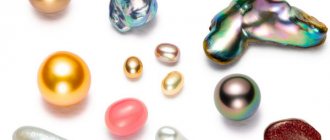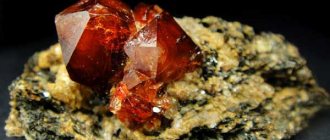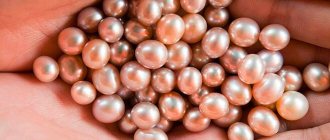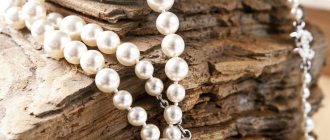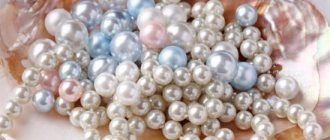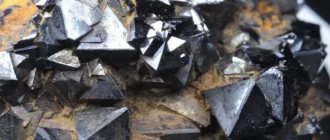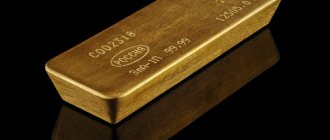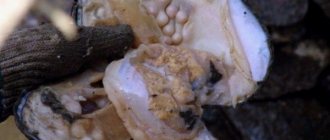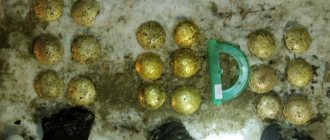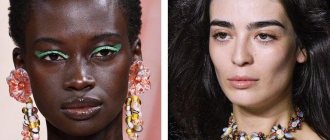Hello! Let's talk about the diversity of pearls in the wild and on man-made farms. The shimmering “surprises” in mollusk shells are a real miracle. People have known the secret of oysters since ancient times. Even then, hundreds of years ago, merchants were ready to pay in gold for natural treasures obtained by divers from the bottom of the seas and oceans. Born in the depths, exclusively all types of pearls are worthy of attention. Just imagine how a sparkling pebble is formed in a shell, how much time it takes and what efforts a person makes to grow the best specimens on his own! You will understand that the high price of pearl products is completely justified.
Let's talk about what types of pearl peas are found in nature, whether any of them can be grown by cultivation and what features they have. We will also consider rare populations of pearl-bearing mollusks, some of which are rightly considered one of the most ancient organisms on Earth.
What determines the “appearance” of a frozen “tear”?
What a pearl looks like depends primarily on the type of oyster. For people, both many hundreds of years ago and today, the color and size of the formations are of greatest value. The shade depends on the following factors:
- varieties and spheres of life of the mollusk;
- overtones;
- reflection.
The main color of the flickering formation is associated not only with the type of organism, but also with the environment in which it lives. An equally important indicator is overtone. Each pearl has an additional shade in addition to the main color. Finally, reflection is the ability of an organic pebble to play with light. The intensity of the color shimmer depends on the number of mother-of-pearl layers.
The longer the formation is inaccessible to humans, ripening inside the shell of the inhabitant of the day, the more saturated its color will eventually turn out. Typically, the most intense overtone and brightness are found in pebbles starting from 0.6 units, often obtained from marine organisms.
The shade is also influenced by the cleanliness of the walls of the body’s shell and the state of its health. In addition, the components in the composition of the water, the temperature of the seabed and water, and other equally important factors play a role.
Typically, pink pearls are formed in the shells of oysters that live in waters with a high amount of manganese in their composition; more often the formations have a standard white or yellowish color, less often - blue, orange, purple and others.
Organic pink pebbles are mined mainly in the Indian Ocean. Their shades vary from beige to pink of varying degrees of intensity. Unusual “drops of mother of pearl” are mined in Panama. This region is characterized by pearls of black and luxurious gold shades. Mexico has absolutely amazing red formations, while Australia and Japan have classic light ones.
Rare and expensive gray pearls are grown mainly on the island of Tahiti. Yellow colored specimens are found in the Red Sea.
Freshwater beads are available in the same variety of colors as marine beads. They have learned to grow them in almost every country.
Let's look at the most interesting varieties with a description of their features.
The healing properties of pearls
Pearls, as you know, are obtained from mollusks. This is an invaluable element of nature, which has been formed over centuries in an ecologically clean water environment. The biologically active mineral emits energy that has a healing effect on the human body.
Pearls have the most beneficial effect on human internal organs. Alternative medicine specialists use pearl water to normalize the functioning of the liver, kidneys and gastrointestinal tract. It is believed that pendants with stones help soothe a sick heart. In this case, only one medium-sized pearl can be used in the form of a pendant.
Pearls, like turquoise, are an excellent indicator of health: if the stone loses its shine or darkens, then it’s time to see a doctor. Pearl is a natural mineral, the components of which interact with our body and normalize its functioning.
In Tibet, the healing properties of pearls are still used for healing in the form of cleansing tinctures. Pearl water is a valuable healing drink that has anti-inflammatory, antibacterial, and hemostatic effects. It's very simple to prepare - dip a few pearls in purified water and leave for several hours in a closed, cool place.
The healing solution helps get rid of gum disease, helps normalize the menstrual cycle, and treats cholelithiasis. It is especially effective to use pearl water to treat eye diseases - it helps with conjunctivitis, cataracts, etc. According to astrologers, pearl water should be prepared on the 1st, 2nd, 28th, 30th days of the lunar month.
Jewelers recommend protecting pearl products from high temperatures, active sun and drying out. To preserve the shine and mother-of-pearl layer of pearls longer, you need to wear them often. This significantly slows down the process of dehydration of pearls and preserves their shine due to the positive effect of sweat glands on the surface of the stone.
Baroque formations: how to identify
Almost all beads of irregular shape, which are as natural as possible for such formations, fall under the “Baroque” category. It is important that baroque pearls refer to material mined in different parts of the world. Its non-standard appearance and unique outline make it attractive to use for inlaying designer jewelry. Instead of the usual ideal sphere, Baroque beads can look like:
- pears;
- drops;
- cylinder;
- buttons.
The most interesting option is paragons.
These are formations with certain specific outlines, for example, birds, animals and even people. This kind of pearl is cultivated by humans, so its price is more affordable than in the case of completely wild organic stones. Jewelry with shaped baroque is chosen for oneself as amulets and talismans. Another distinctive feature of the beads is their ribbed surface. It is enough to move the ball along the sand to see the characteristic wavy patterns. Each baroque pearl is unique, which is confirmed by the high price.
Blister: how to distinguish
The “blister” category includes pearls with an unusual choice for placement inside the shell. If traditionally foreign bodies are overgrown with mother-of-pearl in the mantle of the oyster, then in the case of blisters we are talking about attaching them to one of the inner walls. The result of an erroneous choice is adherence to the wall and the absence of a pearlescent layer at the attachment point.
To hide flaws, jewelers process pearls and often use them to create necklaces and chokers, masking “bald spots” with holes for threads.
Another interesting name for blister beads is bubble, which fully confirms the features of the non-standard appearance.
Characteristic shine
Pearls appear when one layer of mother-of-pearl is layered on top of another on a foreign body (a grain of sand, a fragment of a shell, a torn piece of mother-of-pearl) that has fallen under the shell of a mollusk. The thicker the layer of mother-of-pearl, the longer the mollusk has lived and the brighter the shine of the bead.
How to distinguish sea pearls from river pearls? This is easy to do by its shine - the naked eye can discern that a sea pearl shines brightly, the surface of the bead is milky, shining, glossy .
The surface of a freshwater pearl is dull, the luster is weak, muted, matte . You can distinguish sea pearls of the highest category from river pearls by the specularity of their surface . Pearls clearly reflect the boundaries of surrounding objects and colors. There are significant differences between river and sea pearls.
Soufflé – a pearl “dessert” for everyone
The sweet name was once given to pearls by gemstone expert Jack Lynch. The name, which reflects the essence of obtaining a pebble, suits it perfectly. If it is translated from French, it turns out that we are talking about “pumping up”.
In practice, it looks like this: the core is removed from the “bag” of the body, and a material with the property of swelling from moisture is put in its place. It actually absorbs moisture inside and stretches the pouch. In turn, the body continues to create layers of nacre around the “new” pearl.
As a result of such a small trick, colossal size soufflé beads can be grown in a mollusk shell. The cost of the finished spheres will depend on the thickness of the nacre.
Pearls need careful and caring handling
Pearls are a precious stone of organic origin, which explains their fragility and the need for special care. Although this fact may discourage many from wearing pearl jewelry, most damage can be easily avoided by regular careful care of the stones.
Two things that you should pay special attention to are perfumes and hairsprays. They can affect the color and quality of the pearls, so wear jewelry only after using it, and when you return home, remove the pearls first.
If you notice that your pearls are dirty or dull, gently wipe them with a dry, soft cloth. Use water only as a last resort - if dirt and stuck particles cannot be removed using the method described above.
To wash your pearls, you will need mild soap (or baby shampoo) and a soft brush (the kind you use for manicures). After wet cleaning, blot the stone dry with a soft cloth so that no traces of moisture remain on its surface.
Always remember that the elegant look of your jewelry does not depend on the type of pearl (cultured, akoya, natural, etc.) or even on its cost. The only thing that matters is the well-groomed appearance of the stones and your efforts to maintain it. Due to their fragile nature, even the most expensive pearls can look bad if you don't take care of them.
Keshi – mother-of-pearl “grains”
This is what keshi is called “grains” in Japanese. Small shimmering organic pebbles appear in the bodies of freshwater and sea oysters as “side effects.” The beads were first discovered in a shell after a failed grafting. Despite the fact that the oyster was unable to establish the process of enveloping the main core with nacre, the process was launched for small particles that naturally penetrated inside the pearl sac.
Such pearls are not specially cultivated, despite the fact that they are quite expensive, although they are inferior in price to larger “loose” beads. No one can predict the shape and size of Keshi pearls. They can be either flattened, resembling flower petals, or round or of any irregular shape.
Product care
Being of organic origin, the mineral requires attention and care. When caring for pearl jewelry, you should follow a few simple rules.
- Prevent the contact of cosmetics and perfumes with jewelry.
- Protect from excessive dryness. The mineral needs moisture, otherwise it fades and the mother of pearl delaminates. If products are rarely worn, they should be wiped periodically with a damp cloth.
- The right place for storage is a box, not bags or pouches.
- From time to time, you should clean the beads under running warm water using baby soap and a soft cloth. After this procedure, the pearls (including black ones) will shine and sparkle.
- Avoid exposure to tobacco smoke on the stone, especially on white pearls (which immediately turn yellow as a result).
Subject to proper care, minerals and jewelry made from them will retain their beauty, shine and attractiveness for a long time. A valuable pink stone, snow-white Akoya pearls, an expensive and rare black Tahiti pearl or a simple piece of jewelry equally need careful care.
Kasumi – where it is mined and what is remarkable about it
Authentic kasumi is cultivated in Japan on the lake of the same name. The kernels are planted in the shells of special mollusks artificially grown at the end of the last century.
It is very easy to distinguish kasumi by its non-standard drop shape and especially bright shine with iridescence. The size of the beads is impressive. Usually these are mother-of-pearl beads of different colors and shades up to 2 cm. Such pearls are highly valued on the market and are actively used in jewelry.
1.2. Types of pearls – Tahitian, Akoya and South Sea pearls
Pearls can grow in both sea and fresh water. Saltwater pearls differ in origin - Akoya pearls, Tahitian pearls and South Sea pearls.
Sea pearls Akoya pearls
This cultured pearl is grown in Chinese and Japanese waters (mainly in Southern Japan). Akoya pearls are round, the color of the natural shades of this type of pearl can be warm and cold from blue, cream to soft pink. The size of pearls varies from 2 to 11 mm. The most famous brand that sells these pearls is Mikimoto and, as a rule, these pearls are used in jewelry, because... Akoya pearls command a premium price (due to the low survival rate of Akoya oysters and the difficulty of cultivation).
rice. Akoya pearl sizes
Southern Pearl
This pearl is grown in the Philippines, Australia and Indonesia. These are the largest of all pearls, their size ranges from 9 mm to 20 mm. The color of pearls can be cream, white or golden, and this depends on the color of the nacre of the mother shell. Shapes of southern pearls: round, teardrop-shaped, baroque, tablet, round with characteristic grooves.
rice. The color of southern pearls depending on the color of the shell
Tahitian pearls
Despite the name, it is not produced exclusively in Tahiti; it is also grown on several French Polynesian islands. The size is usually between 8mm and 16mm; These pearls are naturally colored in ranges of blue, purple, green and gray, but they are collectively known as black pearls because... The Tahitian pearl comes from the black-lipped oyster. Currently, Tahitian pearls are considered the most vibrant, popular pearls on the market.
rice. Variety of flowers and black lipped oyster
Freshwater pearls
This type of pearl is usually grown in rivers, ponds and lakes - and predominantly in China. Many of the pearls are white and typically resemble Akoya pearls in both size and shape. However, they can be made in different shapes and come in a variety of pastel colors.
Also, pearls may differ in luster, size, shape, color and surface of the pearls.
rice. Variability of pearls
Conch - a gift from the Caribbean
The Caribbean Sea is home to a special type of single-vave conch oyster. Another variety of natural pearls is named after them. The peculiarity of mollusks is their vulnerability. They cannot be opened without killing them. This fact saved the lives of individuals and the entire population.
Defenseless and small, the organisms continue to live at the bottom of the Caribbean Sea and are not subject to mass extermination. It is prohibited to obtain pearls by killing shellfish, and cultivating them is unprofitable. Nevertheless, rare finds extracted specifically from the shells of conch mollusks “leak” onto the market. Their price is impressively high, despite the fact that the surface is not cast with mother-of-pearl.
Overall, the beads look amazing: an unusual surface similar to frozen silk, an almost flawless shape, available in a wide variety of colors, ranging from lilac to olive and violet specimens.
How to choose natural pearls
In order not to make a mistake with your choice, you should check the proposed pearls for its compliance. The tests are not difficult, and in the end you will be sure that you are buying real pearls.
You can throw a pearl onto a smooth surface of sufficient hardness from a height of about half a meter. Natural pearls, unlike artificial ones, will bounce elastically.
If you have the opportunity to look through a pearl into the sun, you will notice that a natural one will glow blue, and a cultured one will glow green. Confirmation that you have a cultivated specimen in your hands are uneven holes with chips.
You can simply take the pearls in your hands. If you feel cool at the same time, it means they are offering you something natural. If you rub two pearls against each other, a light dust appears, which serves as confirmation of the natural origin of the products.
An original way to determine naturalness is to draw a strip of pearl along the surface of your tooth. Real pearls have microscopic roughness, so they will creak.
Akoya is a Japanese product
The famous akoya originates in a special species of Pinctada bivalves. In Japanese it is "akoya-kai", which explains the origin of the name of the final product. Initially, the formations were cultivated in the ocean waters near the Chinese and Japanese coasts.
Akoya is the most sought after on the market. They can be seen in photos and on shelves in most European and Asian stores. Jewelers and buyers liked the marine spheres for their wonderful shimmer, rich color and regular shape with almost no defects. The price of the products also corresponds to the characteristics.
Akoya pearls are excellent for necklaces and bracelets, primarily due to their almost perfect shape. The natural colors of the formations are cream and white; there are specimens with shades of pink, yellow and green. The first ones are the rarest and therefore are valued the most.
The process of cultivating akoya is not easy. No more than one or two foreign bodies can be “planted” in one shell, while a freshwater mollusk is capable of “bearing” up to 50 mother-of-pearl balls at the same time. In addition, Akoya is considered the smallest pearl oyster among pearl oysters, which further complicates the process.
Types of freshwater pearls
Freshwater mollusks are the source of river pearls. Natural samples are very difficult to obtain. Cultivation is carried out in Germany, Russia (in the northwest), and the United States, but the leader is China.
River beads often have an irregular shape, but artificially grown stones are obtained without flaws. The colors are inferior in variety and richness to the tones of marine samples. Most often these are white pearls, beige, brown. Black is almost never found.
The quality of river pearls is lower than that of sea pearls, which significantly reduces the cost of the former. Its appearance is greatly influenced by its growing conditions.
Keshi
Keisha's elegant and shiny pearls are produced by sea and freshwater oysters. This species does not have a nucleus. Appears as a result of the natural entry of a foreign body into the pearl sac of a mollusk located on an oyster farm.
Keshi is a rare variety, as it is formed only when the embedded kernel is rejected. And due to the constant improvement of artificial cultivation technologies, such force majeure situations occur infrequently. Therefore, there are fewer and fewer such “defective” copies.
The beads are characterized by small sizes - approximately 3 mm. The composition contains only mother-of-pearl, which gives pearls an extraordinary shine and radiance. Another feature is the pistachio and purple shades.
Kasumi
This variety is grown in Japan on Lake Kasumi. The producer is a hybrid mollusk, bred by crossing Chinese and Japanese oysters.
Despite their origin, Japanese Kasumi pearls are much more expensive than sea black pearls. Main characteristics of the variety:
- The main feature is the irregular shape (which is called baroque), round Kasumi pearls are found, but rarely.
- Possible tones: white, pink, golden, greenish, purple or deep black.
- These large pearls are distinguished by a thick layer of mother-of-pearl, adding shine and iridescent tints.
Biwi
The producer of this species is freshwater mollusks. It is cultivated in Japan on Lake Biwa, hence the name. Six months after placing the implant in the shell, the small beads are removed, sorted, placed back and left for another year.
Biwi is famous for its oval shape with jagged edges, which is defined as Baroque. The predominant colors are gray, pinkish-yellow, and gold. A very smooth pink mineral is also found, but much less frequently. The black tone is atypical.
Bivi is a small pearl. Its size is up to 7 mm. However, with a cultivation period of more than one and a half years, the size can reach up to 12 mm. This is a nuclear-free mineral, its composition is pure mother-of-pearl. This gives the stone a delightful shine.
Abalone is a rare species
Among all the varieties, abalone is the least common. The mother-of-pearl formation matures in a single-vave oyster called abalone, that is, abalone. The oyster differs from its fellows in its non-standard anatomical structure, which makes the introduction of an implant into it almost impossible.
Pearls are mined on the coast of the American state of California and near Mexico. In exceptional cases, samples of abalone pearls are found in Japan, Australia, Thailand, New Zealand and even Korea.
Abalone is one of the oldest species of marine organisms. It is believed that it has lived on the planet for more than 30 million years. The pearls formed inside its shell are distinguished by absolutely incredible shades and tints of a mixture of colors.
Jewelers highly value abalone and the brighter the surface, the more you will have to pay for it. The shape of the pearl is also unusual. This is a rarely familiar area. Mostly the formations are oblong. For one abalone pearl up to 4 mm in diameter you will have to pay more than $300, and this is without a frame.
Regular and irregular shape
Even a child will recognize freshwater and sea pearls in a jewelry store. Sea water helps the pearl in the shell to become even, regular, spherical in shape .
Freshwater pearls are found extremely rarely, and this is their artistic feature, which is valued by jewelers. The common shape of freshwater pearls is oval , but ovoid and teardrop-shaped .
Among sea pearls, a separate category is made up of baroque pearls - beads of exquisite fantasy shapes. A good idea on how to distinguish natural pearls from artificial ones is to analyze the price. If a large pearl of regular round shape is sold to you cheaply and without a certificate, it is an imitation.
Freshwater pearls have the following properties: strength, heterogeneous structure, and they are less cool to the touch. If you are interested in how to distinguish natural pearls (river or sea) from artificial ones, remember the rule - pearls seem cool, even if you hold the bead in your hands for a couple of minutes.
What is melo melo and what does it look like?
An interesting variety called melo melo. Visually, it is similar to conc formations. Pearls do not have a mother-of-pearl layer, so at first glance they do not look at all like the usual round shimmering spheres. In fact, this is the same genuine and valuable material, which is confirmed by gemological certificates with the note “not mother-of-pearl” in the description.
Pearls are born in the melo melo sea snail. The oyster lives along the coasts:
- Thailand;
- Cambodia;
- Vietnam.
Finished beads are traditionally colored in shades of red and brown. The orange ones are considered the most expensive.
Melo is a rather rare type of pearl, characterized by its large size. The world record holder is a bead weighing 80 grams, resembling the sun's disk at sunrise. At one time, the “petrified sun” was owned by the Vietnamese emperor.
The most expensive piece of melo was sold for almost half a million dollars at auction. It was an orange pebble with parameters 23x19 mm.
The impossibility of their cultivation adds to the value of melo. In addition, the material reacts especially sharply to light, which makes jewelry with it “evening” status.
Presents from the island of Tahiti: what are they famous for
Black pearls are obtained from a special type of oyster of the pinctada maxima family. The mollusk lives near the coast of French Polynesia. Compared to other types of oysters, “black-lipped” oysters are the largest. The formations inside their shells are just as large, often dark in color with various variations of shades.
Cultivating pearls in pinctada maxima oysters is difficult primarily due to the high mortality of the organisms as a result of grafting. It is this factor that is associated with the demand for black pearls on the market. Dark mother-of-pearl beads are valued higher than light ones and are used to create exclusive jewelry. The average size of one bead is from 8 to 14 mm.
There are several shades of beads, ranging from gray to jet black or dark purple. Less common are specimens of pistachio, eggplant and dark green colors.
